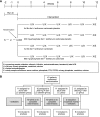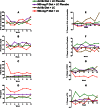Effects of dietary phosphate restriction and phosphate binders on FGF23 levels in CKD
- PMID: 23471131
- PMCID: PMC3675851
- DOI: 10.2215/CJN.09250912
Effects of dietary phosphate restriction and phosphate binders on FGF23 levels in CKD
Abstract
Background: Elevated levels of fibroblast growth factor 23 (FGF23) are associated with increased risk of adverse outcomes in patients with CKD. Reducing dietary phosphate intake or absorption may decrease FGF23 levels, but data on the combined effects of dietary phosphate restriction and phosphate binders in CKD are limited.
Design, setting, participants, & measurements: In this 2×2 factorial, single-blinded, placebo-controlled, 3-month study, conducted between July 2009 and March 2012, 39 patients with CKD stages 3 or 4 and normal serum phosphate levels were randomly assigned to one of four groups: ad libitum diet plus lanthanum carbonate (LC) placebo (n=10), 900-mg phosphate diet plus LC placebo (n=10), ad libitum diet plus LC (n=11), or 900-mg phosphate diet plus LC (n=8). The dose of LC was 1000 mg three times daily with meals. Dietary restriction was accomplished with outpatient counseling. The primary end point was change in FGF23 levels from baseline.
Results: Compared with ad libitum diet, the 900-mg phosphate diet did not significantly reduce FGF23 levels (diet × time interaction, P=0.05). Compared with placebo, LC alone also did not significantly reduce FGF23 levels (LC × time interaction, P=0.21). However, the dual intervention significantly decreased FGF23 levels throughout the study period (diet × LC × time interaction, P=0.02), resulting in a 35% (95% confidence interval, 8%-62%) reduction by study end.
Conclusion: The combination of LC plus counseling for a phosphate-restricted diet decreased FGF23 levels in patients with CKD stages 3-4 and normal serum phosphate levels.
Trial registration: ClinicalTrials.gov NCT00843349.
Figures




References
-
- Isakova T, Wahl P, Vargas GS, Gutiérrez OM, Scialla J, Xie H, Appleby D, Nessel L, Bellovich K, Chen J, Hamm L, Gadegbeku C, Horwitz E, Townsend RR, Anderson CA, Lash JP, Hsu CY, Leonard MB, Wolf M: Fibroblast growth factor 23 is elevated before parathyroid hormone and phosphate in chronic kidney disease. Kidney Int 79: 1370–1378, 2011 - PMC - PubMed
-
- Isakova T, Xie H, Yang W, Xie D, Anderson AH, Scialla J, Wahl P, Gutiérrez OM, Steigerwalt S, He J, Schwartz S, Lo J, Ojo A, Sondheimer J, Hsu CY, Lash J, Leonard M, Kusek JW, Feldman HI, Wolf M, Chronic Renal Insufficiency Cohort (CRIC) Study Group : Fibroblast growth factor 23 and risks of mortality and end-stage renal disease in patients with chronic kidney disease. JAMA 305: 2432–2439, 2011 - PMC - PubMed
-
- Seiler S, Reichart B, Roth D, Seibert E, Fliser D, Heine GH: FGF-23 and future cardiovascular events in patients with chronic kidney disease before initiation of dialysis treatment. Nephrol Dial Transplant 25: 3983–3989, 2010 - PubMed
-
- Faul C, Amaral AP, Oskouei B, Hu MC, Sloan A, Isakova T, Gutiérrez OM, Aguillon-Prada R, Lincoln J, Hare JM, Mundel P, Morales A, Scialla J, Fischer M, Soliman EZ, Chen J, Go AS, Rosas SE, Nessel L, Townsend RR, Feldman HI, St John Sutton M, Ojo A, Gadegbeku C, Di Marco GS, Reuter S, Kentrup D, Tiemann K, Brand M, Hill JA, Moe OW, Kuro-O M, Kusek JW, Keane MG, Wolf M: FGF23 induces left ventricular hypertrophy. J Clin Invest 121: 4393–4408, 2011 - PMC - PubMed
Publication types
MeSH terms
Substances
Associated data
Grants and funding
LinkOut - more resources
Full Text Sources
Other Literature Sources
Medical

